
Real, Unbiased Mary Kay Review from an Ex-MLMer
17 Comments
Table of Contents
- Pink Caddy Anyone?
- Mary Kay Company Overview
- How Mary Kay Started
- Are Mary Kay Products Any Good?
- Pros: Why You Should Be a Mary Kay Consultant
- Cons: Why Mary Kay is Bad
- Compensation Plan: How Mary Kay Works
- Mary Kay: Quick Summary
- Bottom Line: Is Mary Kay Legit or Just Another Pyramid Scheme?
- Shameless Plug: Realistic Passive Income Without MLM?
Pink Caddy Anyone?
Let me take a wild guess:
Even if you’re not a die-hard fan of makeup, cosmetics, or the color pink…
You’ve prob’ly heard of the MLM company Mary Kay for years, right?
Me too.
This skin care and cosmetics giant is one of the largest direct selling companies in the world.
We’re talking about racking up more than $3.5 billion in annual sales.
That’s a lotta skin cream and lipstick flying around.
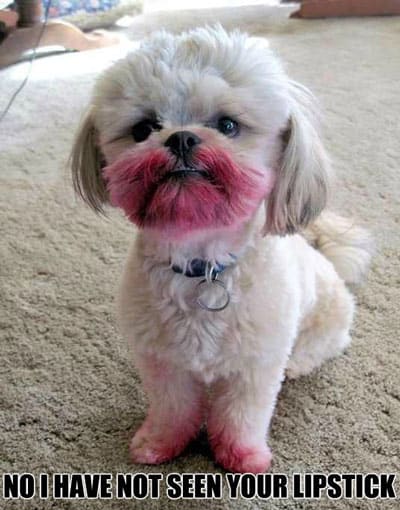
It’s also one of the most recognizable multi-level marketing (MLM) companies in existence.
If you’ve ever seen someone driving one of their trademark pink Cadillacs around town, you know they’ve developed some serious direct sales hustle.
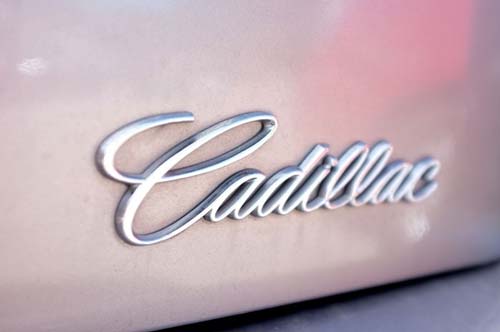
As with many other MLMs, the company has both a good and bad reputation, depending on who you talk to.
So:
How solid is Mary Kay as a home-business opportunity?
Is it really worth it to crank up a ballin’ beauty biz of your own?
Let’s take a closer look at this pillar of the MLM world to see if it really passes the sniff test.
Mary Kay Company Overview
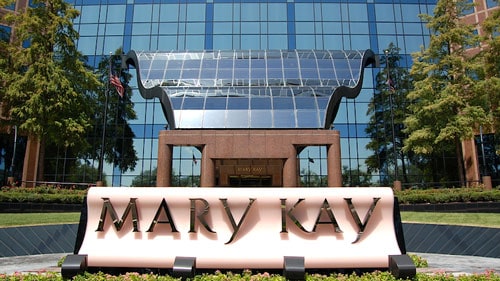
Mary Kay is widely considered to be an iconic name in the beauty industry, right up there with the likes of Sephora and L’Oreal.
The company churns out over 200 premium products in six major categories:
- Facial skin care
- Color cosmetics
- Body care
- Nail care
- Sun protection
- Fragrance
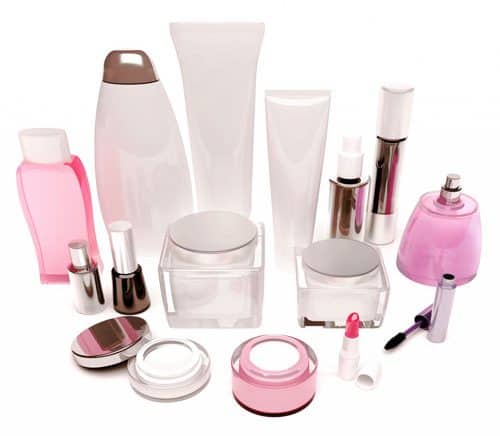
Where Is Mary Kay Headquarters?
Mary Kay’s beauty-centric product line is manufactured in two state-of-the-art facilities.
Dallas, Texas (the location of the company’s international headquarters) and Hangzhou, China.
And in case you didn’t know, it’s all about product quality with Mary Kay.
Which is why they spend millions of dollars each year in product testing, research, performance, and safety.
Even though I barely know the difference between lip balm vs. lipstick, I gotta admit that I’m pretty impressed with how they approach product development.
They’ve also established a significant international presence over the years.
Mary Kay products are now sold in over 35 global markets and that number continues to grow.
The company obviously has a huge footprint in the States.
But some of their largest markets outside of the good ol’ U.S.A. include Mexico, China, and Russia.
The company’s cosmetics products are sold exclusively through their army of Independent Beauty Consultants (IBCs).
Which at last count numbered over 2.4 million strong — that’s a LOT of Skin Care Soldiers out there!
These IBCs purchase products directly from the “mothership” (Mary Kay headquarters).
And then sell those products to customers using a variety of methods including old-school (home parties) and new-school (e-commerce).
From in-person beauty classes to virtual makeovers, IBCs have a Swiss Army knife of traditional and digital tools to help them build their businesses.
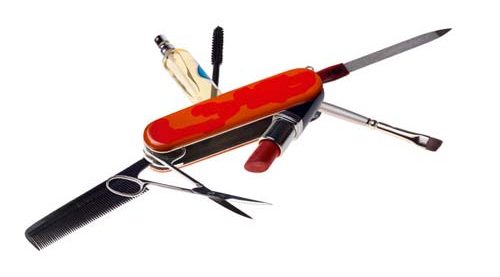
As you’ve probably gathered by now, the company is primarily geared towards women.
For many people, Mary Kay is synonymous with the color pink — very similar to how the pink ribbon is associated with the Komen breast cancer foundation.
The culture of women’s empowerment runs deep in this top network marketing company.
In fact, Mary Kay’s stated motto is “Enriching Women’s Lives”.
The prevailing mindset, especially among the higher-level IBCs, is that positivity should be emphasized at all times.
Any type of negative talk or thinking is unacceptable.
While this sounds great at first glance, this very mindset is also one of the main points of contention for women who have left the business.
In fact, the website Pink Truth is jam-packed with stories of ex-IBCs who found this super-optimistic, Pollyanna-type approach to be a little unsettling.
Especially when they would try to voice valid concerns or criticisms to their leadership.

Instead of approaching things from a level-headed perspective, some upline IBCs would either ignore or completely dismiss any complaints.
In many cases, sincere and critical questions would be met with accusations of “poisoning the business with negativity”.
Or even worse, trying to steal people’s dreams aka being a “dream stealer”.
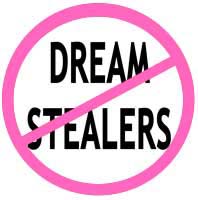
Sound familiar?
After all, you never know how your “negativity” (which is actually just honest and healthy skepticism) might tarnish the image of the business in the eyes of incoming recruits, right?
To be fair, that doesn’t mean that ALL distributors act this way, so you can’t throw the entire company under the bus.
But for those who might not be familiar with these types of disingenuous dealings, let me tell you that it’s not exclusive to Mary Kay.
In fact, this strange brand of hyper-positivity is extremely common in the MLM world, even in up-and-coming companies like doTERRA.
Now, don’t get me wrong.
Having a positive mindset is essential to becoming a successful entrepreneur in ANY business, since major setbacks and challenges are inevitable.
However, there’s a big difference between having a glass half-full vs. half-empty mindset and having the entire bottle dumped down your throat until you choke on it.
Ironically, this is one of the reasons why many people find it so difficult to walk away from MLMs.
Even when they haven’t made one red cent for months, years, or even EVER.
When you know that you’ll be labeled a quitter, non-achiever, or new member of the “Graveyard of Dreams” if you walk away, it makes it that much harder to cut the cord.
Especially if close friends or family are still in the business.
This borderline cult-like behavior is why so many ex-MLMers feel like they’ve been scammed and have such a sour taste in their mouth after walking away.
But, I digress.
On a more positive note, I should also mention that the company is heavily involved in charitable work via the Mary Kay Foundation.
They routinely donate truckloads of money to cancer research and also channel funds towards preventing domestic violence as well.
Gotta respect that.
How Mary Kay Started
As it was with Steve Jobs (Apple), Sam Walton (Walmart) and James Cash Penney (J.C. Penney), the history and ethos of a company is often centered around its visionary leader.
This is definitely the case with Mary Kay.
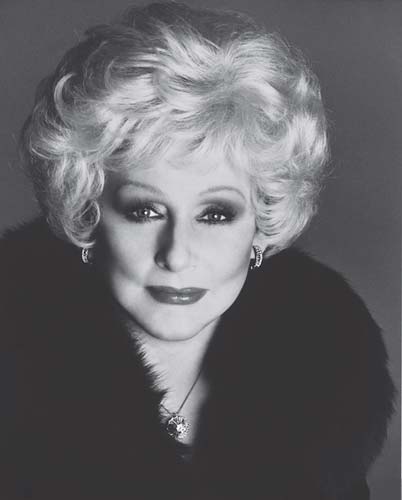
Mary Kay Ash is almost a mythical legend among the distributors of her namesake company.
On September 13th, 1963, Ash made a courageous decision that would forever change her destiny.
At 45 years of age with an investment of $5,000 from her oldest son, she launched Beauty by Mary Kay.
A company that flew in the face of the male-dominated business world at the time.
You have to admire her courage.
At an age when most people would be thinking about “slowing down” and looking forward to retirement, Ash’s goal was to pursue opportunities that had often been denied to women.
And build a business that would create a means of income for her and other women with similar entrepreneurial ambitions.
Let’s just say it worked out pretty well.
More than fifty years later, Mary Kay is now recognized as one of the premier cosmetics companies on the planet.
While Ash passed away in 2001, her legacy of entrepreneurship and women’s empowerment continues to live on.
She has earned high praise from countless notable figures, from former First Lady Laura Bush to famous motivational guru Zig Ziglar.
Ash also received dozens of awards and accolades during her lifetime, even after her passing.
That includes the prestigious Living Legend Award from the Direct Selling Foundation, and also being named the “Greatest Female Entrepreneur in American History” by Baylor University.
Her son Richard R. Rogers now runs the company, operating as Executive Chairman.
As co-founder of the business, Richard has actually been involved from the very beginning, joining forces with his mom at the ripe young age of 20.
The mother-son duo created a company that has become a juggernaut in the beauty space, with billions of dollars in annual sales.
Long story short, more than half a century after Mary Kay began, the company continues to thrive and is obviously doing something right.
Are Mary Kay Products Any Good?
I mentioned earlier that product development was one of the main things that impressed me about this company.
They even have Ph.D.-level biochemists, toxicologists, microbiologists, and pharmacologists on the payroll.
That’s a lotta “gists” for one sentence, but obviously they have some smart folks working behind the scenes to make sure that product decisions are based on sound scientific research.

For example, Mary Kay’s skin care products are tested by a team of independent board-certified dermatologists.
Consumer scientists are also employed to conduct important live product testing (on people, not animals).
In an MLM industry that is rife with inferior (garbage) products, I can comfortably say that this company seems to put some real thought, effort, and pride into what they offer.
Mary Kay also seems to emphasize the idea of maintaining a radiant, youthful appearance by slowing down the inevitable effects of aging on the skin.
Can’t blame ’em for that — I mean, who doesn’t wanna look younger as they get older?
And their products are (allegedly) designed to deliver exactly that for their customers.

Some of their best-sellers include Oil-Free Eye Makeup Remover, Ultimate Mascara, and TimeWise Age-Fighting Moisturizer.
One complaint that has surfaced many times in online forums and discussion boards is the issue of Mary Kay constantly changing their product formulas.
This essentially makes the older products obsolete, and thus a lot more difficult for distributors to sell.
After all, it’s only human nature to want the “new” and “improved” version of anything.
This has become a hot-button issue with a lot of former Independent Beauty Consultants.
Many IBCs have ended up with basements full of older, “outdated” products they find hard to get rid of, since everyone wants the newer versions.
As a result, even though it’s officially forbidden by the company, some distributors have resorted to selling their obsolete products on places like eBay and Amazon.com.
Why?
Just to recoup some of their upfront inventory costs which can be hundreds or even thousands of dollars.
The fact that Mary Kay seems to constantly fiddle with their product formulas does beg the question:
If it ain’t broke, why keep trying to fix it?
But then again, it could be for the same reasons that a new iPhone comes out every year.
(Hint: Billions of reasons.)
Pros: Why You Should Be a Mary Kay Consultant
✓ The company has been around for more than 50 years.
If nothing else, this should set your mind at ease regarding stability.
As a multi-billion dollar business, it doesn’t look like Mary Kay is going bust any time soon.
That being said, stranger things have happened in the MLM universe. Over the years, many popular MLMs have fallen victim to the “here today, gone tomorrow” curse.
✓ Mary Kay provides high quality and professional-looking sales tools to help IBCs build their businesses.
Their website is also top-notch, which goes hand-in-hand with their extensive marketing materials.
✓ There are some juicy financial rewards and incentives.
(For determined entrepreneurs who can endure the Mary Kay grind.)
For example, IBCs can earn up to 50 percent commission on the products they sell.
Top distributors are also treated to financial bonuses, luxury trips, and cool prizes including fine jewelry and cutting-edge tech gadgets.
And let’s not forget one of the most famous signs of Mary Kay achievement — the iconic pink Cadillac, officially known as the “Career Car”.
In recent years, the company has also expanded the Career Car Program to include black BMW’s, Chevrolet’s, and Toyota’s.
These spiffy vehicles are reserved for those that have graduated to the expert-level of awesomeness in the company.
Meaning they won’t hand you the keys to a new Caddy until you’ve generated at least $75,000-$100,000 in sales volume in a six-month period.
Now technically, the Cadillac isn’t really yours — it’s just leased to you.
But there’s a catch:
The company will only give you a monthly amount to cover the car payments if you continue to meet the high volume of sales requirements.
If you fall below the production standards for a given month, the lease payment then becomes your responsibility.
And if that happens for too many months in a row, your shiny new ride goes bye-bye.
Sheesh.
On second thought, maybe the Cadillac should fall into the “Cons” category lol.
Cons: Why Mary Kay is Bad
✗ As is the case with all MLMs, you won’t make any serious money unless you recruit new Mary Kay distributors to your team.
You know the drill:
Make a list of all your friends and family and start selling them Mary Kay products and “the dream”.
✗ The company “updates” or changes their product formulas on a regular basis.
This irritates many IBCs because they are often left with older, outdated inventory that is difficult to sell since everyone wants the newer version.
✗ Many former IBCs have complained about the initial ordering process when you first become a distributor.
You’re only “officially” required to pay $100 for a starter kit to begin your Mary Kay business.
But in order to stay “active”, you need to order at least $225 of wholesale products every three months from the company.
It is, however, common practice for upline mentors to push this inventory amount much higher.
This is a practice called “front loading” and it happens all the time in MLMs.
Mary Kay in particular is notorious for front loading.
New IBCs are often encouraged by their recruiters to purchase inventory packages that range from $600 all the way up to $4800 for a “Pearl Star Package”.
Now think about it: As soon as that inventory purchase is made, the company has their money.
The burden is now completely on the brand-new Independent Beauty Consultant to sell those products to consumers.
More often than not, many of these newbies end up with drawers, closets, or even basements full of products that they can’t sell.
Since the company only tracks sales volume from these inventory purchases via IBCs, there’s no telling how much product actually ends up in the hands of retail customers.
I’m no conspiracy theorist, but I have a sneaking suspicion that a high percentage of that inventory is still in the hands of IBCs.
✗ There seems to be a ton of pressure to meet monthly production numbers with this company.
As mentioned above, IBCs are required to make a $225 minimum order every three months to remain active.
But you can forget about getting a commission check if you fail to meet volume requirements in a given month, even if you were a sales superstar the month before.
Interestingly enough, this volume requirement goes away at the National Sales Director level and above.
Which doesn’t make a whole lotta sense because why would you make it harder for people who are just starting out vs. those who have well-established businesses?
Go figure.
Compensation Plan: How Mary Kay Works

Okay, it’s time to make some hay with Mary Kay!
(I know… so lame.)
But seriously, how do Mary Kay consultants get paid?
Well first of all, there are far too many titles, levels, and qualification requirements to explain in-depth here.
Consultants, Star Consultants, Red Jackets, Team Leaders, Directors-in-Qualification (DIQ), National Sales Directors, the list goes on and on.
As expected, each successive level offers higher commission percentage amounts and the compensation plan rewards sales VOLUME — and lots of it!
To go along with that, the more IBCs you sign up, the higher Team Building bonuses and commissions you’ll receive.
In a nutshell: the more people you recruit onto your team, the more money you can make.
As I mentioned earlier, a lot of emphasis is placed on consistently ordering large amounts of “inventory” to keep your business well-stocked for future customers.
The problem is, what happens if and when those customers never materialize?
Do a quick search on Google and you’ll find horror stories of women who have gone into deep credit card debt trying to make these bulk inventory orders.
(Remember: You have to maintain certain monthly production numbers to keep qualifying for commissions.)
And unfortunately, what chance do you think the average IBC (with little to no sales experience) has at recouping those costs?
Given the abysmal success rates of most MLMs, I would say the chances are slim — at best.
Of course, you’ll be told that the inventory you buy is “a source of future profit”. But obviously, it’s only profit IF you can sell it.
Interestingly enough, I couldn’t find an easily accessible, line-by-line breakdown of the company’s compensation plan on their official website.
In fact, when you search for “Mary Kay compensation plan” on Google, the official website doesn’t even show up anywhere on the first page.
After doing some digging, I finally found an Advance Brochure (apparently only accessible to active IBCs) from the Pink Truth website.
Not sure why the company is so secretive about their compensation plan.
But given the amount of naysayers out there regarding network marketing companies, perhaps I shouldn’t be.
Mary Kay: Quick Summary
| PROS | CONS |
|---|---|
| Mary Kay has been around for more than 50 years and is a multi-billion-dollar business i.e. doesn‘t look like the company is going bust any time soon. | As is the case with all MLMs, you won‘t make any serious money unless you recruit new Mary Kay distributors to your team. |
| Independent Business Consultants can earn up to 50 percent commission on the products they sell. | Many former IBCs have complained about the initial ordering process and "front loading" of products when you first become a distributor. |
| Mary Kay provides high quality sales tools for their IBCs including a top-notch website and extensive marketing materials. | Due to front loading and frequent product updates, there are many complaints of having large amounts of “inventory” leftover they can't sell. |
| There are some juicy rewards waiting for top distributors including financial bonuses, luxury trips, fine jewelry and cutting-edge tech gadgets. | High pressure to meet monthly production numbers e.g. IBCs are required to make a $225 minimum order every three months to remain active. |
| Top IBCs can qualify for the iconic "Career Car" which include company-leased pink Cadillacs, black BMW‘s, Chevrolet‘s, and Toyota‘s. | Mary Kay admits in an earnings report that out of their active IBCs, only about half earned commissions more than $100 annually. |
Bottom Line: Is Mary Kay Legit or Just Another Pyramid Scheme?
Look:
Mary Kay Ash is undoubtebly an inspirational figure and she built one heckuva cosmetics company.
Nobody can deny that.
The company offers stability and great brand recognition which are pretty rare in today’s world of fly-by-night MLMs.
They also seem to produce highly-rated products.
But I do have serious concerns about how viable Mary Kay’s business opportunity is for the average person.
Front loading, high-pressure production requirements, and the whole enforced positive attitude thing are real turn-offs.
And let’s not forget the fact that out of the roughly 650,000 IBCs in the U.S., only about 1300 of them (0.2%) have hit the Pink Cadillac level.
To take it a step further, according to research 99% of all network marketers will fail to make money after business expenses are taken into consideration.
Now to be fair, that horrific “success rate” is on par with any MLM that operates today.
Even in one of Mary Kay’s own earnings reports, they admit that only about 12% of their IBC sales force was considered “active”, and only half of them earned commissions more than $100 annually.
Ouch.
But here’s the thing:
Clearly Mary Kay wouldn’t still be in business after almost 60 years if at least some women weren’t experiencing success with the company.
So I think it’s only fair to also include some pro-Mary Kay rebuttals to many of the anti-Mary Kay sites out there.
Even the popular CBS television show 60 Minutes did a fascinating story about Mary Kay and her company back in 1979:
That being said, after many hours of research, I think for most folks the negatives far outweigh the positives of Mary Kay’s business opportunity.
If you’re gonna invest your hard-earned money and time into a business, you should look for one that offers a higher potential of return.
Just my two cents.
Then again, I can’t help but admire and respect the hustle of Mary Kay and strong entrepreneurial women like her.
So if you wanna drink the pink lemonade and have that Mary Kay enthusiasm down in your heart, I wish you all the best.
If not, here’s some other suggestions.
Shameless Plug: Realistic Passive Income Without MLM?
Imagine this:
No recruiting, no selling products, no rah-rah meetings, no bullsh*t.
Don’t believe me?
Don’t blame you.

But before you scream “SCAM!” and scram, do yourself a favor.
Put down the Hatorade and click here to discover more realistic ways to make passive income from home.
Years ago my sister hosted a Mary Kay party, and the sales associate was a friend. We guests were good sports, including my sister’s boyfriend. We started with a cleansing. The boyfriend first, but he whined it stung. I went next, and ended up with chemical burns to my face.
My sister helped me rinse lots of water trying to stop the burning sensation. I had to go the my doctor that same day, who then sent me to a dermatologist who chewed me out for not first testing a new product on my arm.
Never tried Mary Kay again, and never will.
Hey DeeDee, thanks for taking the time to share your experience.
DeeDee,
I have been a Mary Kay consultant for 5 years, and I could never imagine something like this happening at one of my parties.
I have extremely sensitive, fair skin and have tried even the harshest Mary Kay products (with retinol, glycolic acid, sunscreen, and exfoliating alumina) and I have never had this type of issue.
You must either have a rare allergy or, because your boyfriend experienced stinging as well, a consultant who used expired products. 🙁
Sidenote: Mary Kay products have expiration codes on them, and consultants are expected to dispose of products nearing expiration. Unfortunately, I have seen thousands of expired products for sale on eBay, Poshmark, and other online marketplaces.
I’m sorry this happened to you, but I hope you find a reputable consultant and give the products another chance.
Former pink Cadillac senior sales director here and this is my thought on doing MK as a business… don’t. If you choose to still go through with it, it’s important who you sign up with and I would recommend contacting one of the good national sales directors who offers good support.
Appreciate your input Sarah, thanks!
Hello!! As a independent Sales Director I’m constantly looking to see what the public sees. I appreciated this review. I appreciate that while stating your opinion that also there was a respect for other viewpoints.
I’ve been in my business for 3 years. I follow the legacy of how Mary Kay Ash wanted this opportunity to truly enrich women’s lives. While it may not be the fastest way to the top no one in my unit is in debt or regretful of their business. There is no pressure.
I truly feel that anyone looking to do a Direct Sales company should definitely do their research as well as interview the recruiter. It is so important.
While we do have season limited edition products the miracle set was just updated after 18 years on the market and was updated to better handle pollutions and change in lifestyle for our customers. We still have products Mary Kay Ash used herself as well ❤️
Hey Sandy, thanks so much for your input! I have a lot of respect for Mary Kay Ash. She was an amazing woman and a shining example for any aspiring entrepreneur. I’m admittedly not a huge fan of the MLM business model, but I’m glad you’re having success with it 🙂
I’ve been a consultant for two years. I actually joined as a personal user and only have a few customers. I’m hoping to grow that at some point, but for now I get to use these amazing products at 50 percent off.
My advise is to know why you are doing it, and be very clear with your team regarding goals. I know I’ve let my team down by not being a regular sales producer…but I always stand firm and remind them “WHY” I said yes. Personal use discount.
Their products are truly amazing- and I love all things make up and skin care. When I get pressured, I offer to walk away and buy from my friend instead. That always stops the pressure.
My friend who encouraged me to join is a “friend” and doesn’t push me past my comfort zone, and doesn’t want me to experience any financial hardship trying to sell products, so it works perfectly for me for now.
Hey Susan, it sounds like you’ve found a nice middle ground with Mary Kay. Thanks for sharing your experience 🙂
I agree with both Susan and Sandy, I’ve been fortunate to have a Director who never, ever pressured me for order. She also taught us money management for business expenses like catalog mailings and gifts with purchase for our customers.
There are MK Wolves out there and I do my best to avoid them. I laughingly refer to myself as the “Un MK Lady” My customers know I’d be happy to assist if they want to start a business, but if they just want to buy it that’s fine, too.
Mary Kay does work if you do, but managing an inventory is key– I call it “just in time” inventory management. Because I order frequently customers waiting a week for an order is unusual. I track sales and know that 80% of my sales come from 20% of MK products.
Never was in it for the Caddy or even the jewelry, but my skin looks and feels great. Thanks for the fair, objective review. I’ll share it with my customers.
Thanks for your insight Kerri 🙂 It sounds like you have the right mindset and personality for MLM.
Thanks!
Thanks for reading John! Glad you enjoyed it 🙂
I’m stunned first of all, that so many women have rooms, basements, closets full of products that they can’t sell, yet continue to replenish the inventory and continue to see no profit… these women aren’t in business for themselves., yet I have seen many posts of MK bots claiming that it is ‘their own business.”.
Anyone with an ounce of common sense would know that 50% commission on a product they bought at wholesale from Mary Kay, leaves a remaining 50% profit.. and who gets that profit? Mary Kay, of course.
Also, all the talk about ‘pressure’ ..how about reading the consultant agreement before signing it? If you signed nothing stating you are required to purchase inventory, then why purchase it?
Finally, if consultants can’t sell the inventory they foolishly purchased, do they really expect other ‘recruits’ to sell ? I don’t see how anyone is making money at all.
Thanks for your comment, Christine! Not being a fan of MLMs myself, I understand your viewpoint.
But once you’re inside the “MLM machine” (using their products, going to meetings & events, etc) — it’s hard to see the forest for the trees after a while.
MLM companies spend a fortune to instill a positive and strong-willed mindset in their distributors, which can sometimes look and feel like brainwashing to some folks. Especially since there’s a fine line between persistence and delusion.
On the other hand, Mary Kay wouldn’t still be around after 50 years and doing $3 billion per year if it wasn’t working for some distributors. So like always, to each their own 🙂
Christine,
To clarify the business model, consultants purchase products at 50% of the retail value. They then sell them for *typically* 100% of the retail value, resulting in a profit.
The commission aspect comes from team production once IBCs start to recruit team members, which is not a requirement. Many consultants are only interested in having the 50% discount for personal use.
I’m sure those basements full of product are from a huge initial order from consultants who 1) didn’t put in the effort to actually sell their products or 2) encountered a life change that made it impossible to run their business.
It is definitely not the same consultants that have stockpiled, sitting inventory who are working to recruit others.
I just want you and other readers to see that Mary Kay or MLM in general is not to blame for consultants that don’t make the best business decisions. 🙂
Thanks for your input, Miranda. While I agree that ultimately it’s the consultant who is in charge of their own success or failure, there are other reasons why MLMs have such a poor reputation.
From pushy uplines who encourage clueless new recruits to purchase as much inventory as possible, to endless rah-rah meetings that only show the successful 1% of MLMers who make it, to recruiting vulnerable people who don’t understand the realities of the business model… just to name a few.
I’m not saying these apply in all cases, but it’s common enough that you can’t put all the blame on the consultants. But that’s just my 0.02 🙂